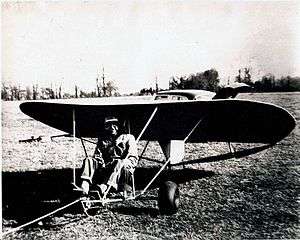Kissinger-Crookes Flying Saucer
The Kissinger-Crookes Flying Saucer is a high-wing homebuilt glider based on the Amcraft Products model aircraft.
| Kissinger-Crookes Flying Saucer | |
|---|---|
 | |
| Role | Homebuilt aircraft |
| National origin | United States of America |
| Designer | Curtiss Kissinger, LeRoy Crookes |
| Unit cost |
$60 in 1958 |
Design and development
The Flying Saucer is the first in a series of aircraft designs from Curtiss Kissinger, and LeRoy Crookes capable of carrying a pilot. It received a Patent No. 2,864,567.
The prototype was built using EMT electrical conduit. The wings use pine wood spars, and 1/8 inch plywood covering. The wing chord varies from center to tip to form a circular shape. The wings fold in segments for road travel.[1]
Operational history
The flying saucer was towed aloft on flight tests with a Nash Rambler. The prototype suffered structural damage on the first flight tests.
Specifications (Kissinger-Crookes Flying Saucer)
Data from Sport Aviation
General characteristics
- Capacity: 1
- Length: 14 ft (4.3 m)
- Wingspan: 11 ft (3.4 m)
- Height: 4 ft 6 in (1.37 m)
- Wing area: 123 sq ft (11.4 m2)
- Empty weight: 210 lb (95 kg)
Performance
- Stall speed: 30 kn (35 mph, 56 km/h)
References
- Sport Aviation. April 1959. Missing or empty
|title=(help)
This article is issued from Wikipedia. The text is licensed under Creative Commons - Attribution - Sharealike. Additional terms may apply for the media files.